Show Me Pictures of Different Squash
How To Purchase and Prepare Perfect Squash
Check out my large collection of Squash Recipes.
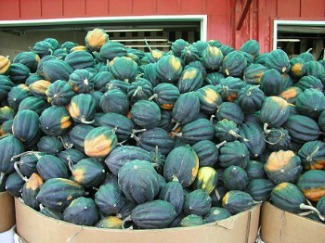
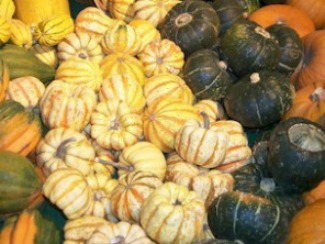
The Definition of Squash: The fruits of various members of the gourd family, which fall into two classifications, summer squash and winter squash.
Did You Know? Every part of the squash plant can be eaten, including the leaves and tender shoots, which can be cooked in omelets or made into soup.
The term summer and winter for squash are only based on current usage, not on actuality. Summer squash types are on the market all winter; and Winter squash types are on the markets in the late summer and fall, as well as winter. Thus, the terms Summer and Winter are deceptive and confusing. This terminology was never meant to confuse – it just dates back to a time when the seasons were more crucial to man's survival than they are now.Good keepers became known as winter vegetables if they would keep until December.
Winter squash comes in shapes round and elongated, scalloped and pear-shaped with flesh that ranges from golden-yellow to brilliant orange. Most winter squashes are vine-type plants whose fruits are harvested when fully mature. They take longer to mature than summer squash (3 months or more) and are best harvested once the cool weather of fall sets in. They can be stored for months in a cool basement-hence the name Winter squash.
Types of winter squash – The most popular winter squash varieties available:
Winter squash come in many shapes and colors. No two look exactly alike. The different varieties of winter squash may be substituted for each other in your many squash recipes. Winter squash are also packed with antioxidants and vitamins (and have not fats), and can be prepared sweet or savory. Be creative and try different types of winter squash!
Most of the following photos of various types of squash were taken by myself at Sterino Farms and Produce Market in Fife/Tacoma, Washington.
Acorn Squash
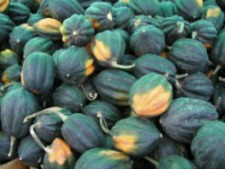 Easily found in supermarkets. As the name suggests, this winter squash is small and round shaped like an acorn. One of my favorite baking squashes, it is easy to slice into halves and fill with butter.
Easily found in supermarkets. As the name suggests, this winter squash is small and round shaped like an acorn. One of my favorite baking squashes, it is easy to slice into halves and fill with butter.
A small acorn squash weighs from 1 to 3 pounds, and has sweet, slightly fibrous flesh. It's distinct ribs run the length of its hard, blackish-green or golden-yellow skin. In addition to the dark green acorn, there are now golden and multi-colored varieties.
Available year round.
Ambercup Squash
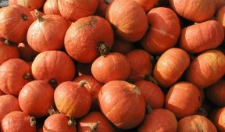 A relative of the buttercup squash that resembles a small pumpkin with orange skin. Bright orange flesh has a dry sweet taste. Peel it, cube the flesh, roast it, and serve like cut-up sweet potatoes.
A relative of the buttercup squash that resembles a small pumpkin with orange skin. Bright orange flesh has a dry sweet taste. Peel it, cube the flesh, roast it, and serve like cut-up sweet potatoes.
Great texture with no stringyness, is a sweet mild flavor, and is a gorgeous color. Has an extraordinarily long storage life.
Available June to November.
Autumn Cup Squash
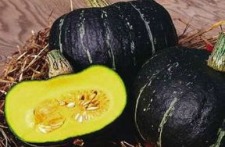 A hybrid of Buttercup/Kabocha type dark green squash. Rich flavored flesh and high yields. Fruit size 6 inches with a weight of about 2 to 3 pounds. Flesh is a gorgeous yellow/orange meat that is stringless, sweet, and fine textured.
A hybrid of Buttercup/Kabocha type dark green squash. Rich flavored flesh and high yields. Fruit size 6 inches with a weight of about 2 to 3 pounds. Flesh is a gorgeous yellow/orange meat that is stringless, sweet, and fine textured.
Excellent storage variety of squash.
Available September through December.
Banana Squash
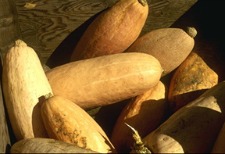 In shape and skin color, this winter squash is reminiscent of a banana. It grows up to 2 to 3 feet in length and about 6 to 8 inches in diameter. It's bright orange, finely-textured flesh is sweet tasting. Banana squash is often available cut into smaller pieces.
In shape and skin color, this winter squash is reminiscent of a banana. It grows up to 2 to 3 feet in length and about 6 to 8 inches in diameter. It's bright orange, finely-textured flesh is sweet tasting. Banana squash is often available cut into smaller pieces.
It is considered top tier among winter squash as it is one of the most versatile squash available.
Available year-round – peak season lasts summer through early fall.
Butternut Squash
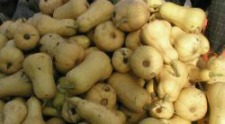 Easily found in supermarkets. Beige colored and shaped like a vase or a bell. This is a more watery squash and tastes somewhat similar to sweet potatoes. It has a bulbous end and pale, creamy skin, with a choice, fine-textured, deep-orange flesh with a sweet, nutty flavor. Some people say it is like butterscotch. It weighs from 2 to 5 pounds. The oranger the color, the riper, drier, and sweeter the squash. Butternut is a common squash used in making soup because it tends not to be stringy.
Easily found in supermarkets. Beige colored and shaped like a vase or a bell. This is a more watery squash and tastes somewhat similar to sweet potatoes. It has a bulbous end and pale, creamy skin, with a choice, fine-textured, deep-orange flesh with a sweet, nutty flavor. Some people say it is like butterscotch. It weighs from 2 to 5 pounds. The oranger the color, the riper, drier, and sweeter the squash. Butternut is a common squash used in making soup because it tends not to be stringy.
Available year-round – peak season lasts from early fall through winter.
Buttercup Squash
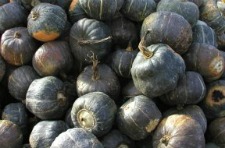 Buttercup Squash are part of the Turban squash family (hard shells with turban-like shapes) and are a popular variety of winter squash. This squash has a dark-green skin, sometimes accented with lighter green streaks. Has a sweet and creamy orange flesh. This squash is much sweeter than other winter varieties.
Buttercup Squash are part of the Turban squash family (hard shells with turban-like shapes) and are a popular variety of winter squash. This squash has a dark-green skin, sometimes accented with lighter green streaks. Has a sweet and creamy orange flesh. This squash is much sweeter than other winter varieties.
Buttercup Squash can be baked, mashed, pureed, steamed, simmered, or stuffed and can replace Sweet Potatoes in most recipes.
Available year-round – peak season lasts from early fall through winter.
Carnival Squash
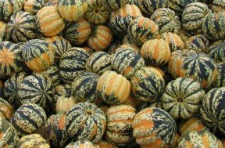 Cream colored with orange spots or pale green with dark green spots in vertical stripes. Carnival Squash have hard, thick skins and only the flesh is eaten. It is sometimes labeled as a type of acorn squash.
Cream colored with orange spots or pale green with dark green spots in vertical stripes. Carnival Squash have hard, thick skins and only the flesh is eaten. It is sometimes labeled as a type of acorn squash.
The delicious yellow meat is reminiscent of sweet potatoes and butternut squash and can be baked or steamed then combined with butter and fresh herbs. Also great in soups.
Available year-round – is best late summer through early fall.
Delicata Squash
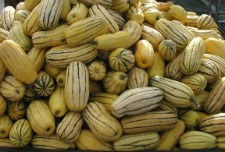 Also called Peanut squash and Bohemian squash. This is one of the tastier winter squashes, with creamy pulp that tastes a bit like corn and sweet potatoes. Size may range from 5 to 10 inches in length. The squash can be baked or steamed. The thin skin is also edible.
Also called Peanut squash and Bohemian squash. This is one of the tastier winter squashes, with creamy pulp that tastes a bit like corn and sweet potatoes. Size may range from 5 to 10 inches in length. The squash can be baked or steamed. The thin skin is also edible.
The delicata squash is actually an heirloom variety, a fairly recent reentry into the culinary world. It was originally introduced by the Peter Henderson Company of New York City in 1894, and was popular through the 1920s. Then it fell into obscurity for about seventy-five years, possibly because of its thinner, more tender skin, which is not suited to transportation over thousands of miles and storage over months.
Available year-round – is best late summer through early fall.
Fairytale Pumpkin Squash
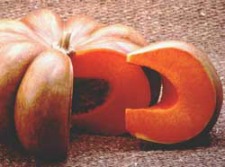
French name is Musquee de Provence. The fruits are flattened like a cheese but each rib makes a deep convolution. The Fairytale Pumpkin is a very unique eating and ornamental pumpkin. It is thick but tender, and the deep orange flesh is very flavored, sweet, thick, and firm. It is a 115 to 125 day pumpkin and takes a long time to turn to its cheese color.
The distinctive coach-like shape and warm russet color makes it also perfect for fall decorating. This pumpkin is usually used for baking. Cut it into pieces and bake in the oven.
Available September to November.
Gold Nugget Squash
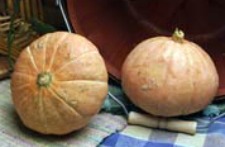
A variety of winter squash, which is sometimes referred to as an Oriental pumpkin that has the appearance of a small pumpkin in shape and color. It ranges in size from one to three pounds. Golden nugget squashes are small, weighing on average about 1 pound. Both the skin and the flesh are orange.
Gold Nugget Squash may be cooked whole or split lengthwise (removing seeds). Pierce whole squash in several places, and bake halved squash hollow side up.
Available year-round – is best season is late summer through early winter.
Hubbard Squash
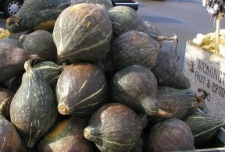 The extra-hard skins make them one of the best keeping winter squashes. These are very large and irregularly shaped, with a skin that is quite "warted" and irregular. They range from big to enormous, have a blue/gray skin, and taper at the ends. Like all winter squash, they have an inedible skin, large, fully developed seeds that must be scooped out, and a dense flesh. Hubbard squash, if in good condition initially, can be successfully stored 6 months at 50 to 55 degree F. with 70% relative humidity. Hubbard squash is often sold in pieces because it can grow to very large sizes. They are generally peeled and boiled, cut up and roasted, or cut small and steamed or sauteed. This squash is perfect for pies.
The extra-hard skins make them one of the best keeping winter squashes. These are very large and irregularly shaped, with a skin that is quite "warted" and irregular. They range from big to enormous, have a blue/gray skin, and taper at the ends. Like all winter squash, they have an inedible skin, large, fully developed seeds that must be scooped out, and a dense flesh. Hubbard squash, if in good condition initially, can be successfully stored 6 months at 50 to 55 degree F. with 70% relative humidity. Hubbard squash is often sold in pieces because it can grow to very large sizes. They are generally peeled and boiled, cut up and roasted, or cut small and steamed or sauteed. This squash is perfect for pies.
Available year-round – peak season is early fall throughout winter.
Kabocha Squash
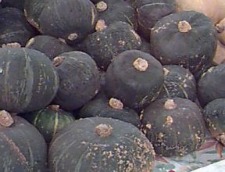 Also know as a Ebisu, Delica, Hoka, Hokkaido, or Japanese Pumpkin. Kabocha is the generic Japanese word for squash, but refers most commonly to a squash of the buttercup type. This squash has a green, bluish-gray or a deep orange skin, The flesh is deep yellow,
Also know as a Ebisu, Delica, Hoka, Hokkaido, or Japanese Pumpkin. Kabocha is the generic Japanese word for squash, but refers most commonly to a squash of the buttercup type. This squash has a green, bluish-gray or a deep orange skin, The flesh is deep yellow,
It has a rich sweet flavor, and often dry and flaky when cooked. Use in any dish in which buttercup squash would work.
Available year-round.
Spaghetti Squash
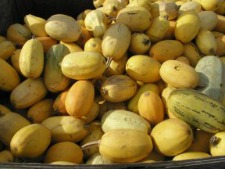 Also called vegetable spaghetti, vegetable marrow, or noodle squash. A small, watermelon-shaped variety, ranges in size from 2 to 5 pounds or more. It has a golden-yellow, oval rind and a mild, nutlike flavor. The yellowiest Spaghetti squash will be the ripest and best to eat. Although it may seem counterintuitive, larger spaghetti squash are more flavorful than smaller ones. When cooked, the flesh separates in strands that resemble spaghetti pasta.
Also called vegetable spaghetti, vegetable marrow, or noodle squash. A small, watermelon-shaped variety, ranges in size from 2 to 5 pounds or more. It has a golden-yellow, oval rind and a mild, nutlike flavor. The yellowiest Spaghetti squash will be the ripest and best to eat. Although it may seem counterintuitive, larger spaghetti squash are more flavorful than smaller ones. When cooked, the flesh separates in strands that resemble spaghetti pasta.
Spaghetti Squash can be stored at room temperature for about a month. \Spaghetti squash also freezes well.
Available year-round – season early fall through winter.
Sweet Dumpling Squash
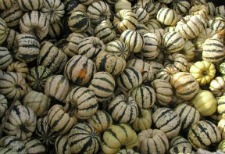
This small, mildly sweet-tasting squash resembles a miniature pumpkin with its top pushed in. It has cream-colored skin with green specks. Weighing only about 7 ounces, it has sweet and tender orange flesh and is a great size for stuffing and baking as individual servings.
Sweet dumplings are tiny but great for roasting and presenting whole.
Available throughout the fall.
Turban Squash
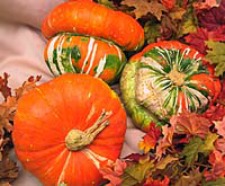
Named for its shape. Turban Squash has colors that vary from bright orange, to green or white. It has golden-yellow flesh and its taste is reminiscent to hazelnut. Has a bulb-like cap swelling from its blossom end, come in bizarre shapes with extravagant coloration that makes them popular as harvest ormenentals.
It is popular for centerpieces, and its top can be sliced off so it can be hollowed and filled with soup. A larger variety of the buttercup squash, the turban has a bright orange-red rind. It's flesh and storage ability are comparable to the buttercup squash. Use in recipes that call or pie or sugar pumpkin.
Available year-round – season is late summer through early fall.
Winter Squash
Winter squash matures on the vine and develops an inedible, thick, hard rind and tough seeds. Choose firm, well-shaped squash that are heavy for their size and have a hard, tough skin. Do not choose those that have sunken or moldy spots. Avoid squash with cuts or punctures in the skin. Also, slight variations in skin color do not affect flavor. A tender rind indicates immaturity, which is a sign of poor quality in winter squash varieties.
To Store Winter Squash:
Place whole winter squash on top of thick pads of newspapers in a cool, dry, well-ventilated location, preferably between 45 and 50 degrees F. Check on a regular basis for rot and use within three to six months depending on variety of squash.
Refrigerate tightly wrapped cut pieces of winter squash, such as banana, and use within 5 days.
Once a squash is cooked (by steaming or baking), the flesh of the squash can be stored frozen until needed.
To Prepare and Use Winter Squash:
Look for squash that feels heavy for its size and has hard, deep-colored skin free from blemishes.
All varieties are great for puring, roasting and baking. Once squash is cooked and mashed, it can be used in soups, main dishes, vegetable side dishes, even breads, muffins, custards and pies.
Cooking Winter Squash:
When cooking pumpkin and squash recipes, remember that any sweet, orange-fleshed pumpkin or squash can be substituted for another in recipes.
Winter squash can be cut in halves or pieces.
Dress any cooked winter squash with butter and herbs, a cream sauce, cheese sauce, maple syrup and nuts, marinara sauce or stewed fruit.
Any type of mashed or pureed squash can be used in the place of canned pumpkin in soups, pies, cookies or quick breads. Chunks of squash can be added to soups, stews and casseroles.
Preparing Winter Squash:
To cook them, first remove fibers and seeds. Wash the exterior of the squash just before using. The seeds are scooped out before or after cooking. Then bake, steam, or boil the squash.
Using Water When Cooking Winter Squash:When water is used in cooking the squash, the quantity of water should be kept small to avoid losing flavor and nutrients.
Peeling Winter Squash:Because this rind makes most squash difficult to peel. it is easier to cook the unpeeled squash, and then scoop out the cooked flesh. As many recipes do require peeling (and cutting) first. Use a vegetable peeler to remove the skin and when cutting hard winter squashes.
Cutting Winter Squash:Winter squash have a hard skin and flesh (this includes acorn, buttercup, butternut, calabaza, delicate, Hubbard, spaghetti, sweet dumpling, and Turban, as well as pumpkin). To cut winter squash in half, grasp the squash firmly and use a sharp knife to slice through to the center. Then flip and cut the other side until the squash falls open. Remove and discard the seeds.Hint: Place the whole winter squash in the microwave for 3 minutes; then cut it easily, remove seeds, add butter, etc, and put into hot oven to bake. (Perforate with knife before putting in microwave so it will not explode.)
To Bake Winter Squash:
Using a whole (1 to 1 1/2 pound) winter squash, pierce the rind with a fork and bake in a 350 degree F. oven 45 minutes. Acorn and butternut squash are frequently cut in half, baked, and served in the shell.
Boil or Steam Winter Squash:
Cut into quarters or rings 25 minutes or until tender. Boil or mash winter squash just as you would potatoes. Add peeled squash cubes to your favorite soups, stews, beans, gratins and vegetable ragouts.
To Make Squash Puree:
Cut winter squash (any type) in half lengthwise and remove seeds. Place squash, cut side down, in a shallow pan on aluminum foil or Silpat-lined baking sheet. Bake at 350 degrees F. until squash is soft, approximately 45 to 60 minutes (depending on the size of your squash). Remove from oven and let cool. When cool, scoop out the cooked flesh/pulp (discarding the shell), place the pulp in a food processor and process until smooth. Measure out the amount you need for your recipe, and reserve any remaining pulp (either in the refrigerator or freeze) for other uses.NOTE: This Squash Puree may be substituted in any recipe that calls for pumpkin puree.
To Microwave Winter Squash:
Place halves or quarters, cut side down, in a shallow dish; add 1/4 cup water. Cover tightly and microwave on HIGH 6 minutes per pound.
Whole Squash – Poke squash all over with a fork. Microwave the squash at full power (High) approximately 5 to 10 minutes (depending on size of squash).
Testing Winter Squash for Doneness:
Test for doneness by piercing with a fork. Fork should easily pierce peel and flesh. Let sit until cool enough to handle, cut in half lengthwise, scoop out seeds (if needed), and proceed with recipe or eat.
Summer Squash
To Prepare and Use Summer Squash:
Thoroughly scrub each squash under running water until the skin feels clean. Then cut off and discard the stem end and scrape off the other end. Only if the skin is unusually tough or the surface feels especially gritty after washing, is it necessary to peel the squash. Most summer squash is now ready to be used in any recipe. Depending on your recipe, you may grate, slice, or cut into pieces of various shapes.
To steam summer squash:
Arrange the slices/pieces of squash in a strainer or rack over 1/2-inch of boiling water. Cover and steam just until barely tender. Remove from heat and drain well. Toss with melted butter or your favorite sauce.
To saute summer squash:
Cook in butter over medium-high heat until barely tender. Season with herbs of your choice, salt, and pepper.
Squash Equivalents:
1/3 to 1/2 pound raw unpeeled squash = 1 serving
1 pound peeled squash = 1 cup cooked, mashed
2-1/2 pounds whole squash = 2-3/4 to 3 cups pureed
1 pound trimmed squash = 2 cups cooked pieces
1 pound squash = 2 to 3 servings
12 ounces frozen squash = 1-1/2 cups
1 medium-size (15 to 20 pounds) pumpkin = 5 to 7 quarts of cooked pumpkin.
Favorite Squash Recipes:
Check out all my many Squash Recipes.
Remember that different types of winter squash may be substituted for each other in your favorite squash recipes.
Freezing Squash:
(Cocozelle, Crookneck, Pattypan, Straightneck, White Scallop, Zucchini)
Freezing Summer Squash:
Choose young squash with tender skin.Wash and cut in 1/2-inch slices. Water blanch 3 minutes. Cool promptly, drain and package, leaving 1/2-inch headspace. Seal and freeze.Grated Zucchini (for Baking) – Choose young tender zucchini. Wash and grate. Steam blanch in small quantities 1 to 2 minutes until translucent. Pack in measured amounts into containers, leaving 1/2-inch head space. Cool by placing the containers in cold water. Seal and freeze.If watery when thawed, discard the liquid before using the zucchini.
Freezing Winter Squash:
Wash and cut squash into small pieces, remove seeds and peel. Cook until soft. Mash pulp or put through sieve. Cool by placing pan containing squash over crushed ice and stir until cool. Place in an appropriate freeze bag, or container, with 1/2-inch headspace; freeze.
Toasted Squash and Pumpkin Seeds:
Squash and Pumpkin seeds are a great healthy snack and a delicious addition to salads, granola or trail mix. According to the University of South Carolina's Cancer Prevention and Control Program, winter squash is low in calories and fat, and rich in antioxidants, fiber, and several vitamins and minerals.
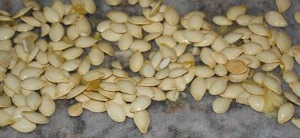
Different ways to clean seeds:
Separate the squash or pumpkin seeds from the stringy membrane of a freshly opened squash. Rinse the seeds in a colander until they are free of any membrane matter. Spread the seeds on clean kitchen towels or layer of paper towels and dry thoroughly.
Throw the whole mess (fibers and seeds) in the oven and once they are dried out, the seeds separates very easily. If you want to use this technique, roast the fibers and seeds together, spread in an even layer on a baking sheet, at 375 degrees F. until the fibers dry out and fall away from the seeds
Roasting or toast seeds:
Coat 1/2 cup of cleaned seeds with 1 teaspoon olive oil and 1/2 teaspoon seasoning of your choice. You only need enough oil to barely coat the seeds, otherwise, they will be greasy. You can use any seasoning blend you like. Adjust the amount to your taste buds.
Line a baking sheet with parchment paper or aluminum foil.
Spread prepared seeds out in an even layer on the prepared baking sheet.
Place in 250 degree F. oven for about 1 hour, stirring every 15 minutes. They are done when they are light brown in the toasted. Remove from oven and let cool before serving.
You can eat the seeds whole (hull and all) or crack them to remove the inside.
Additional seasoning ideas:
Try additional seasonings on your squash or pumpkin seeds: Cajun seasoning, soy sauce, Worcestershire sauce, and garlic salt are some of the many possibilities.
Storing Roasted Seeds:
Store baked squash or pumpkin seeds in an airtight container.
Substitute them in for your usual nut or seed topping.
Sources:
The Sweet & Savory Sides of Winter Squash, by Ris Lacoste, Taunton Press.
The Squash Cookbook, by Yvonne Young Tarr, Wings Books.
What's Cooking America kitchen with Linda Stradley.
Winter Squash Good Keepers in Produce Department, by Patricia Aaron, Sept. 24, 2003.
Wonderful Winter Squash, by Terra Brockman, Conscious Choice, October 2002.
Show Me Pictures of Different Squash
Source: https://whatscookingamerica.net/squash.htm
0 Response to "Show Me Pictures of Different Squash"
Post a Comment